National emblem of Belarus
The national emblem of Belarus features a ribbon in the colors of the national flag, a map of Belarus, wheat ears and a red star. It is sometimes referred to as the coat of arms of Belarus, although in heraldic terms this is inaccurate as the emblem does not respect the rules of conventional heraldry. The emblem is an allusion to one that was used by the Byelorussian SSR, designed by Ivan Dubasov in 1950, with the biggest change being a replacement of the Communist hammer and sickle with an outline map of Belarus. The Belarusian name is Dziaržaŭny herb Respubliki Biełaruś (Дзяржаўны герб Рэспублікі Беларусь), and the name in Russian is Gosudarstvennyĭ gerb Respubliki Belarusʹ (Государственный герб Республики Беларусь).
| National emblem of Belarus | |
|---|---|
.svg.png.webp) | |
| Armiger | Republic of Belarus |
| Adopted | June 7, 1995 (Minor modifications in 2012) |
| Crest | Red star of Communism |
| Blazon | Globe, rising sun, and outline map of Belarus |
| Supporters | Stalks of wheat, clover and flax covered in the colors of the national flag. |
| Motto | Рэспубліка Беларусь (Republic of Belarus) |
| Earlier version(s) | .svg.png.webp) |
| Use | Coat of arms of Belarus from 1991 to 1995 |
Between 1991 and 1995, Belarus used a coat of arms, known as the Pahonia as its national emblem. The Pahonia was originally a symbol of the Grand Duchy of Lithuania, of which Belarus had historically been a part.[1]
Description

Design
In the center of the emblem sits a green outline of Belarus, superimposed over the rays of a golden sun. The sun is partially covered by a globe, with the landmass (part of Eurasia) in purple and waters in blue. Lining the left and right sides of the emblem are stalks of wheat, superimposed with flowers. Clovers adorn the left wheat stalks; flax flowers adorn the right. Wrapped around the wheat stalks is a red and green ribbon bearing the colours of the flag of Belarus; the ribbon meets at the base of the emblem, where the name Republic of Belarus (Рэспубліка Беларусь) is inscribed in gold in Belarusian. At the top of the emblem there is a five-pointed red star.[2]
Symbolism
The elements that comprise the state emblem are not tied to any "official" symbolism. The design of the emblem of the Byelorussian SSR was used as the basis for the current Belarusian emblem; the primary difference between the two is that the Byelorussian SSR emblem contains more references to Communism, such as the Communist symbol of hammer and sickle and pure red ribbon with Communist mottoes, which the modern emblem does not, replaced with the outline and the flag of Belarus, respectively, however it still retains the communist red star, the red ribbon (albeit without the mottoes), the globe and the wheat bundles, which are also typical of Soviet emblems and still is very Soviet in nature.
Legislation

The current law regulating the design and use of the Belarusian emblem was passed on July 5, 2004. Article 9 of Chapter 3 of Law No. 301-3 begins by describing the official drawing of the Belarusian arms and regulates on its proper design. Officially, the arms can be drawn in full colour, monochrome or using two colors. Article 10 states that the national emblem must be displayed at specified locations on a continual basis, such as the residences of the Belarusian leader, the chamber of the National Assembly and at governmental offices of national and regional levels.
The emblem can also be used on documents issued by the government, including money, passports and official letterheads.[3] In addition, the emblem displays is been appeared on all ballot boxes, campaign mailings and on promotional standards when the election is starting. It also appears on their border posts between Belarus and Russia.[4]
The law also restricts the use of the emblem in other contexts—e.g. cities, towns or oblasts may not adopt a coat of arms or emblem using the national emblem either completely or in part. Furthermore, organizations not listed in the Law on State Symbols may only use the emblem by permission. The emblem can be used by both foreigners and citizens of Belarus, as long as the symbol is displayed with respect, although citizens may not use the state emblem on letterheads or business cards if they are not agents of the government.[3]
History
Pahonia
The Pahonia was used as an official coat of the Grand Duchy of Lithuania since 1366 after being first used as the personal arms of Algirdas, the Grand Duke of Lithuania. The arms continued to be used until Grand Duchy of Lithuania were annexed by the Russian Empire in 1795, though the arms was incorporated into the Imperial coat of arms.[5] The idea of return to the historic national symbol was pursued by Belarusian poet Maksim Bahdanovič in his poem "Pahonia". The arms was again used in 1918 when the short-lived Belarusian People's Republic used the Pahonia as its emblem.
More recently, the Pahonia was the official coat of arms starting in 1991, when Belarus declared itself independent of the Soviet Union. It was replaced by the current emblem following a controversial referendum held in 1995.
Since it was dropped as the official emblem of Belarus, opposition groups such as the Belarusian People's Front have used the Pahonia as part of their own party symbols or used them as a form of protest against Belarusian leader Alyaksandr Lukashenka.[6]
_cut.png.webp) Coat of arms of the Grand Duchy of Lithuania since the 16th century
Coat of arms of the Grand Duchy of Lithuania since the 16th century The Pahonia part of the Coat of arms of the Polish–Lithuanian Commonwealth
The Pahonia part of the Coat of arms of the Polish–Lithuanian Commonwealth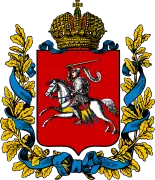 The Pahonia on the coat of arms of the Vitebsk Governorate of the Russian Empire (from 1856)
The Pahonia on the coat of arms of the Vitebsk Governorate of the Russian Empire (from 1856) The Pahonia on the coat of arms of the Vilna Governorate of the Russian Empire
The Pahonia on the coat of arms of the Vilna Governorate of the Russian Empire The united coat of arms of the White Russia's and Lithuanian Provinces from Coat of arms of the Russian Empire (1882)
The united coat of arms of the White Russia's and Lithuanian Provinces from Coat of arms of the Russian Empire (1882)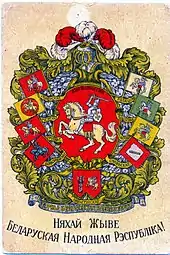 The Pahonia as the symbol of the Belarusian Democratic Republic (from 1918, no unified design of the coat of arms was approved)
The Pahonia as the symbol of the Belarusian Democratic Republic (from 1918, no unified design of the coat of arms was approved) The Pahonia as a symbol of the Belarusian Democratic Republic
The Pahonia as a symbol of the Belarusian Democratic Republic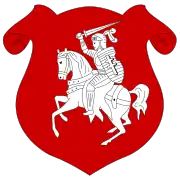 The Pahonia as depicted in passports issued by the Belarusian Democratic Republic
The Pahonia as depicted in passports issued by the Belarusian Democratic Republic Seal of Belarusian Central Rada in 1943–1944
Seal of Belarusian Central Rada in 1943–1944.svg.png.webp) Coat of arms of Belarus from 1991 to 1995
Coat of arms of Belarus from 1991 to 1995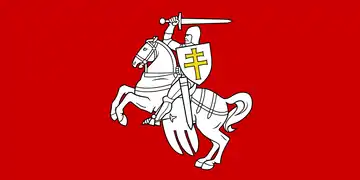 Heraldic banner of the Pahonia coat of arms
Heraldic banner of the Pahonia coat of arms_with_Arms_(2020).svg.png.webp)
 Current coat of arms of Lithuania (since 1992)
Current coat of arms of Lithuania (since 1992)
Emblem of the Byelorussian SSR
From 1920 until the fall of the Soviet Union in 1991, the Byelorussian SSR used an emblem instead of a coat of arms. The first emblem used by Soviet Belarus was adopted in 1919 and is similar to the contemporary insignia of the Russian and Ukrainian republics. The central part of the emblem is a stylized red shield, showing a golden sun rising from the base. Above the sun is a crossed golden hammer and sickle, symbolizing unity between workers and peasants. Above the hammer and sickle, the letters Б.С.С.Р are shown in black, denoting the name of the republic. БССР (BSSR) is an abbreviation for the full name of the republic; "Беларуская Савецкая Сацыялістычная Рэспубліка", the Byelorussian Soviet Socialist Republic. The shield is framed by ears of wheat meeting at its base and featuring a red ribbon inscribed in black with the state motto of the Soviet Union, "Workers of the World, Unite!" The text is written in the Belarusian language.[7]
In 1937, this emblem was replaced by a new one, removing the shield and including more text. The right side of the emblem features oak leaves and the left features wheat ears with clovers placed on top. In the center of the emblem, a sun is rising behind a profile of Earth. A hammer, sickle and red star appears over the sun. Around the ears of wheat and leaves of oak is a red ribbon, featuring the phrase "Workers of the World, Unite!" written (from left to right) in Belarusian, Yiddish, Polish and Russian. The initials Б.С.С.Р are shown at its base denoting the name of the republic. Ten years before in 1927, the arms was the same except for the wording on the bottom ribbon. Instead of the letters reading БССР, the letters read "С.С.Р.Б", which stood for the Soviet Socialist Republic of Byelorussia.[8]
This emblem was in turn replaced by a new one in 1950. The central feature of this symbol is a crossed hammer and sickle, a universal Communist symbol symbolizing the unity of workers and peasants. Below this symbol, a sun is shown rising behind a globe. The insignia is framed by ears of wheat, each ear ending in flowers; clover on the left and flax on the right. A red ribbon is wrapped around the ears of wheat, reminiscent of the red flag used by the Communist movement. The base of the emblem shows the letters БССР. The ribbon features the phrase Workers of the World, Unite! The left side inscribed in Belarusian, the right side in Russian. The red star of Communism is featured above the hammer and sickle. The 1950 version was designed by Ivan Dubasov, a People's Artist of the USSR.[8] Article 119 of the Constitution of the Byelorussian SSR defines the design of the emblem.[9]
.svg.png.webp) 1919–1927 coat of arms
1919–1927 coat of arms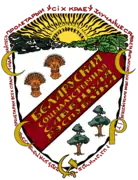 1924 proposed coat of arms
1924 proposed coat of arms.svg.png.webp) 1927–1937 coat of arms
1927–1937 coat of arms.svg.png.webp) 1937–1938 coat of arms with the inscription Workers of the World, Unite! (from left to right) in Belarusian, Yiddish, Russian and Polish
1937–1938 coat of arms with the inscription Workers of the World, Unite! (from left to right) in Belarusian, Yiddish, Russian and Polish.svg.png.webp) 1938–1949 coat of arms
1938–1949 coat of arms.svg.png.webp) 1958–1981 coat of arms
1958–1981 coat of arms.svg.png.webp) modification from 1981 until 1991
modification from 1981 until 1991
1995 referendum
On May 14, 1995, a referendum was conducted in all regions of Belarus. Out of four questions, one was the following: "Do you support the introduction of the new national symbols?" With a voter turnout of 64.7%, the new state symbols were approved by a ratio of 3:1 (75.1% to 24.9%). The way the referendum was carried out was heavily criticized by the opposition, including the exact wording of the question about the national insignia.[10] Supporters of the Pahonia also criticize that the Pahonia and the former white-red-white flag were compared to ones, used by collaboration forces, in propaganda that was published during the run-up to the vote.[11] The comparison was made as the white, red, white flag and Pahonia being used on the patches and symbols of the Belarusian Central Rada, the Belarusian government under the control of Nazi Germany. Alexander Lukashenko claimed the selection of the Soviet-inspired symbols as a victory, especially to his Great Patriotic War veteran base, by saying "we have returned to you the flag of the country for which you fought. We have returned to you both memory and a sense of human pride."[12]
In February 2020, the Belarusian parliament updated the emblem, with the globe centred on Belarus and showing more of Europe, rather than Russia and the colour of the outline map of the country changed from green to gold.[13][14]
 Coat of arms of Belarus as defined in 1995
Coat of arms of Belarus as defined in 1995.svg.png.webp) Proposed coat of arms of Belarus
Proposed coat of arms of Belarus
See also
References
- http://www.hubert-herald.nl/Bielorus.htm
- President of the Republic of Belarus Description of the National emblem. Retrieved March 1, 2006.
- (in Russian) Republic of Belarus Law No. 301-3 Law of the National Symbols of the Republic of Belarus. Retrieved March 1, 2006.
- (in Russian) State Border Troops Committee of the Republic of Belarus Symbols of the Border Guard. Retrieved 21 November 2006. Archived January 7, 2009, at the Wayback Machine
- "The Coat of Arms of Lithuania". Seimas of the Republic of Lithuania. 2006-01-10. Retrieved 2008-10-29.
- (in Belarusian) Symbols of the Belarusian People's Front. Retrieved 7 March 2006. Archived December 28, 2008, at the Wayback Machine
- Heraldicum History of the Soviet Byelorussian emblem. Retrieved November 3, 2006. (in Russian)
- Гербы БССР. Геральдикум (in Russian). Русский Центр флаговедения и геральдики. 2003-12-16. Retrieved 2010-04-28.
- Anon (1972). Флаг и Герб СССР. Moscow. p. 26.
- Belarus Guide - National Symbols in Belarus: The Past and Present. Retrieved 5 August 2006.
- Belarus Guide - Pahonia. Retrieved 7 March 2006.
- Belarus News and Analysis Vitali Silitski - A Partisan Reality Show. May 11, 2005. Retrieved 7 March 2006.
- "Less Russia, More Europe On Belarus's New Symbol-To-Be". RadioFreeEurope/RadioLiberty. 2020-02-13. Retrieved 2020-02-14.
- "«Об изменении Закона Республики Беларусь «О государственных символах Республики Беларусь» | Законопроекты и Декреты, поступившие на рассмотрение в Палату представителей | Официальный сайт Палаты Представителей Национального собрания Республики Беларусь". house.gov.by (in Russian). Retrieved 2020-02-14.
External links
- President of the Republic of Belarus Official description of the National Emblem of Belarus
- (in Russian) 2004 Law on the National Symbols of Belarus
- (in Russian) 1995 Law on the National Emblem of the Republic of Belarus
- (in Russian) Brief history of Belarusian symbols
- (in Russian) Heraldicum - Emblems of the Republic of Belarus